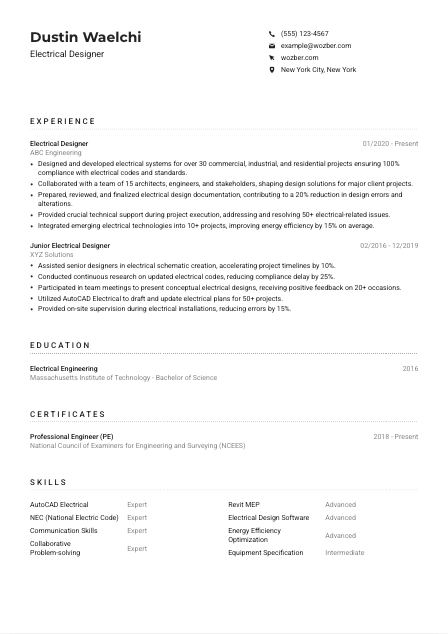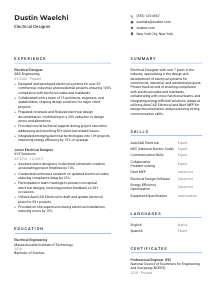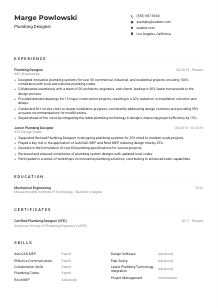Electrical Designer Resume Example
Circuiting blueprints, but your resume seems crossed? Light up with this Electrical Designer resume example, wired with Wozber free resume builder. It illuminates how you can integrate your design finesse with job prerequisites, making your career pathway as efficient as a well-wired circuit board!

How to write an Electrical Designer Resume?
Greetings, aspiring Electrical Designer! If you're ready to spark interest with your next employer and illuminate your career path, you've landed in just the right spot. Crafting a standout resume isn't just about listing your experiences; it's about connecting your electrifying skills and achievements with what hiring managers are looking for. With the right voltage of advice, the Wozber free resume builder, and an ATS-friendly resume template, we'll ensure your resume not only glows but also passes the ATS optimization with flying colors.
Ready to switch on your career? Let's dive in!
Personal Details
Think of the 'Personal Details' section as the circuit board of your resume – it powers the first impression. To kick off a current of interest, it's essential to connect your contact info directly to the job's requirements. Let's electrify this section with precision and care.
1. Name as Your Brand
Present your name prominently, like the main switch on a control panel. Ensure it's in a clear, readable font – this is the first step in branding yourself as an Electrical Designer.
2. Job Title Precision
Directly below your name, illuminate your aspiration by matching the job title "Electrical Designer". This alignment primes the ATS and hiring manager to recognize you as an ideal candidate.
3. Essential Contact Geometrics
- Phone Number: Ensure your contact number is error-free. A misplaced digit can mean a missed opportunity.
- Professional Email: Your email should echo professionalism. Opt for a clean format like firstname.lastname@email.com, steering clear of novelty addresses.
4. Geolocating
Highlighting your location as "New York City, New York" attunes to the job's locational requirement. It reassures employers of your availability without the need for relocation arrangements.
5. Digital Blueprint
If applicable, including a LinkedIn profile can add depth to your resume. It's an additional platform to project your professional narrative and past projects, so make sure it's up-to-date and reflects your resume.
Takeaway
The 'Personal Details' section is your resume's foundation. Ensure it's robust, accurate, and perfectly aligned with the role you're eyeing. Think of it as your professional handshake – make it count!





Experience
In the world of Electrical Design, your experience illuminates your path. It's where you showcase projects that have been powered by your expertise. Let's ensure this section shines brightly and aligns with the specifications of your desired role.
- Designed and developed electrical systems for over 30 commercial, industrial, and residential projects ensuring 100% compliance with electrical codes and standards.
- Collaborated with a team of 15 architects, engineers, and stakeholders, shaping design solutions for major client projects.
- Prepared, reviewed, and finalized electrical design documentation, contributing to a 20% reduction in design errors and alterations.
- Provided crucial technical support during project execution, addressing and resolving 50+ electrical‑related issues.
- Integrated emerging electrical technologies into 10+ projects, improving energy efficiency by 15% on average.
- Assisted senior designers in electrical schematic creation, accelerating project timelines by 10%.
- Conducted continuous research on updated electrical codes, reducing compliance delay by 25%.
- Participated in team meetings to present conceptual electrical designs, receiving positive feedback on 20+ occasions.
- Utilized AutoCAD Electrical to draft and update electrical plans for 50+ projects.
- Provided on‑site supervision during electrical installations, reducing errors by 15%.
1. Circuit Analysis
Kickoff by dissecting the job description. Identify keywords and phrases such as "designed and developed electrical systems" or "collaborated with cross-functional teams" that match your own experiences. This ensures your resume speaks the same language as the job description.
2. Structuring Your Projects
Arrange your professional experience like a neatly schematized circuit diagram. Start with your current or most recent position and work backward. Ensure each role is clearly marked with your title, company name, and the dates of your tenure.
3. Detailing Accomplishments
For each role, illuminate your contributions with specific accomplishments. Use action verbs to bring energy to your descriptions. For instance, "Designed and developed electrical systems for 30+ projects, ensuring 100% compliance with electrical codes" showcases both your activity and its impact.
4. Quantifying Success
Integrate metrics to provide scale and context to your achievements. Numbers convey the scope of your work and its impact in a universally understandable way. 'Reduced design errors by 20%' speaks volumes about your precision and expertise.
5. Relevant Experience Highlight
While diverse experience is valuable, in this circuit, the current flows strongest through relevant paths. Tailor this section to reflect the job description, emphasizing your design work on commercial, industrial, or residential projects, as well as your proficiency with necessary design software.
Takeaway
The 'Experience' section is where you demonstrate your capability and impact. Each bullet point is a testament to your contributions and a beacon calling out to potential employers. Tailor this section with care, ensuring it resonates with the job you're applying for.
Education
Your educational background provides the foundational voltage for your career as an Electrical Designer. It's critical to display this information in a way that resonates with your role's specifications. Let's energize this section with targeted information.
1. Voltage Requirement
Start by matching the educational requirements of the job description. For an Electrical Designer, noting your "Bachelor's degree in Electrical Engineering" directly aligns with the job's primary requisite.
2. Structuring Your Credentials
Layout your education in a clear, straightforward manner: the degree you earned, the field of study, followed by the institution and your graduation year. This offers a quick, at-a-glance understanding of your educational background.
3. Degree Precision
If your degree directly matches the job requirement, make it prominent. In this case, "Bachelor of Science in Electrical Engineering," explicitly aligns with the desired qualifications, making it a high-voltage highlight of your application.
4. Current Courses
Including relevant courses or workshops can add depth to your educational background, especially for recent graduates. For seasoned professionals, this may include continuing education that's specific to electrical design innovations or software proficiencies.
5. Additional Circuits
If you've been part of engineering clubs, relevant academic projects, or societies, mention them. Such activities demonstrate your passion and drive for the field beyond classroom learning. However, measure this against the context of your overall experience to keep it pertinent.
Takeaway
Your 'Education' section is the grounding of your career potential. It shows where you've come from and the foundational knowledge you bring. Ensure it's accurately tailored to meet the job requirements, and let it serve as the strong base from which your skills and experiences extend.
Certificates
In the electrically dynamic field of design, certifications can provide an additional charge to your qualifications. Here's how to ensure this section boosts your candidacy, resonating with the vigor and precision required for an Electrical Designer.
1. Compliance with Requirements
Although the job description might not explicitly demand certifications, including relevant ones, such as a "Professional Engineer (PE)" licensure, can set you apart. It signals ongoing dedication to your field and an edge in technical competence.
2. Selective Amplification
Choose certifications that bolster your claim to the Electrical Designer role. Quality trumps quantity. Highlighting certificates that directly relate to electrical design software, code compliance, and technical mastery ensures relevance.
3. Date Encoding
Validity is key in certain certifications. If applicable, note the acquisition or renewal dates to indicate your credentials are current. This transparency is valuable, particularly in fields subject to evolving standards.
4. Continual Circuit Refresh
The field of electrical design is continuously evolving. Stay plugged into new learning opportunities and certification programs. They not only enhance your skillset but also demonstrate your commitment to staying at the cutting edge of your profession.
Takeaway
Your 'Certificates' section adds extra proof of your expertise and commitment to your craft. While not all certifications may be directly requested in the job description, they substantiate your technical prowess and dedication to professional growth. Keep this section charged with relevant, up-to-date certifications.
Skills
The 'Skills' section of your resume is like your toolbox – it showcases the specific tools you wield as an Electrical Designer. Let's map out how to arrange this toolbox, making it as accessible and relevant to the job as possible.
1. Circuit Mapping
Begin by tracing the skills outlined in the job description. Identifying both explicit skills like "Proficiency with electrical design software" and implicit skills such as "Strong interpersonal and communication skills" allows you to echo the job's needs with your skillset.
2. Prioritizing Tools
Position skills that align directly with the job requirements at the forefront. For instance, rank your expertise in "AutoCAD Electrical" and familiarity with "NEC (National Electric Code)" as top tools. This deliberate placement signals your proficiency where it matters most.
3. Functional Arrangement
While it's tempting to showcase a wide array of skills, concentrate on those that power up your candidacy for the Electrical Designer role. A clutter-free toolbox, with skills like "Collaborative Problem-solving" and "Energy Efficiency Optimization," speaks of focused proficiency.
Takeaway
Your 'Skills' section is a showcase of your professional capabilities. It's a condensed inventory of the tools you bring to the Electrical Designer role. Curate this list with care, focusing on what's most relevant and impressive. Let it reflect the breadth and depth of your expertise, tailored precisely to the job at hand.
Languages
In our increasingly connected world, the ability to communicate across languages can add significant value to your role as an Electrical Designer. Let's navigate how to amplify your linguistic skills in line with your application.
1. Essential Wiring
Identify the languages explicitly requested in the job description. For an Electrical Designer in New York City, a solid grasp of "English" is a given. Prioritize this at the top of your languages section, clearly marking your proficiency level.
2. Adding Circuits
In addition to the primary language, list any other languages you are proficient in. While the job may not call for them, additional languages indicate adaptability and readiness for diverse environments or global projects, adding breadth to your capabilities.
3. Clarifying Signal Strength
Be precise about your language proficiency levels. Terms like "Native," "Fluent," or "Intermediate" give hiring managers a clear signal of your ability to communicate in different linguistic frequencies. Transparency here avoids any crossed wires down the line.
4. Frequency Matching
While the Electrical Designer role might mainly require proficiency in English, understanding additional languages can prime you for projects with international stakeholders or documentation. This broader linguistic range could set you apart in a crowded field.
5. Amplifying Global Resonance
Consider the broader scope of the role and the company's market presence. If they're global, your additional language skills could be a significant asset, paving the way for smoother international project execution and teamwork.
Takeaway
Your language skills are conduits to broader communication and understanding in a globalized work environment. While English may power most of your professional interactions in this role, additional languages boost your profile, showcasing versatility and a capability for cross-cultural collaboration.
Summary
Crafting an energizing summary at the start of your resume sets the tone for everything that follows. This is your chance to capture the hiring manager's attention with a high-voltage pitch of your qualifications. Let's create a summary that radiates confidence and clarity.
1. Powering Up
Initiate with a vibrant opening line that reflects your overall professional persona. For instance, introducing yourself as an "Electrical Designer with over 7 years in the industry" immediately establishes tenure and relevance.
2. Illuminating Highlights
Shed light on your key skills and notable achievements. Referencing experiences like designing and developing electrical systems for a variety of projects, ensuring compliance with codes, or integrating energy-efficient solutions, directly addresses core job requirements.
3. Wattage Control
Keep your summary concise and electrifying. Aim for 3-5 powerful lines that encapsulate who you are as a professional. This isn't the place for detailed project descriptions; rather, it's an opportunity to spark interest and invite the reader to learn more about your accomplishments.
4. Connection Points
Ensure your summary connects directly to key aspects of the job you're applying for. Highlighting your proficiency in software like AutoCAD Electrical and Revit MEP, for instance, demonstrates your preparedness for the specific technical demands of the Electrical Designer role.
Takeaway
Your summary is the beacon that guides the hiring manager through the rest of your resume. It's an opportunity to condense your professional story into a potent statement of your qualifications. Make it resonate with the role's requirements, ensuring it pulses with the energy and expertise you bring to the table.
Launching Your Electrical Designer Journey
Congratulations, you've just completed an in-depth guide to building an ATS-compliant resume tailored for an Electrical Designer role. With these insights, Wozber's free resume builder, and a keen focus on ATS optimization, you're ready to apply with confidence. Remember, your resume is more than a document; it's a distillation of your professional essence. Use Wozber's ATS-friendly resume templates and ATS resume scanner to ensure your application doesn't just pass the automated test but also stands out to human eyes.
The path to your next great opportunity is now well-lit. Charge forward and make your mark!

- Bachelor's degree in Electrical Engineering or related field.
- Minimum of 5 years experience in electrical design for commercial, industrial, or residential projects.
- Proficiency with electrical design software such as AutoCAD Electrical or Revit MEP.
- Familiarity with NEC (National Electric Code) and other relevant electrical codes and standards.
- Strong interpersonal and communication skills to collaborate effectively with cross-functional teams.
- Must have a solid grasp of English.
- Must be located in New York City, New York.
- Design and develop electrical systems for client projects, ensuring compliance with all electrical codes and standards.
- Collaborate with architects, engineers, and other stakeholders to understand project requirements and provide electrical expertise.
- Prepare and review electrical design documentation, including schematics, calculations, and equipment specifications.
- Provide technical support during project execution, addressing any electrical-related issues or modifications.
- Stay updated with emerging electrical technologies and trends, integrating them into design solutions where appropriate.















